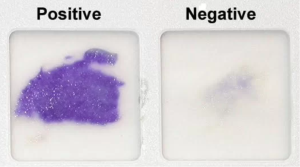29 Oxidase Test
Emilie Miller, Ph.D
In aerobic respiration, the final electron acceptor (i.e., the one having the most positive redox potential) at the end of the ETS is an oxygen molecule (O2) that becomes reduced to water (H2O) by the final ETS carrier. This electron carrier, cytochrome oxidase, differs between bacterial types and can be used to differentiate closely related bacteria for diagnoses. For example, the gram-negative opportunist Pseudomonas aeruginosa and the gram-negative cholera-causing Vibrio cholerae uses cytochrome c oxidase, which can be detected by the oxidase test, whereas other gram-negative Enterobacteriaceae, like E. coli, are negative for this test because they produce different cytochrome oxidase types. (OpenStax CNX, 2018)
Microbes that possess cytochrome c, contain cytochrome c oxidase to facilitate electron and proton transfer to oxygen. In this scenario, the cytochrome is the reducing agent because in this step of the ETS, it is the source of the electrons. In the oxidase test, the reagent becomes the source of the electrons. It is a chromogenic reducing agent (CRA). It produces a color change when it gives up its electrons. This reducing agent readily transfers its elections to cytochrome c oxidase. As the colorless CRA becomes oxidized, it becomes deep purple.
![]() The particular CRA used, tetramethyl-p-phenylenediamine, does not transfer electrons to other cytochromes or to other ETS components because its reduction potential is lower than that of the other cytochrome types. The electrons cannot flow “up” the redox tower. The CRA will transfer electrons to cytochrome c oxidase because this enzyme complex has a lower reduction potential and will spontaneously accept them.
The particular CRA used, tetramethyl-p-phenylenediamine, does not transfer electrons to other cytochromes or to other ETS components because its reduction potential is lower than that of the other cytochrome types. The electrons cannot flow “up” the redox tower. The CRA will transfer electrons to cytochrome c oxidase because this enzyme complex has a lower reduction potential and will spontaneously accept them.
In this test, the timing is important. If the moistened reagent is exposed to air for too long, it will spontaneously become oxidized, by substances other than cytochrome C oxidase. When this happens it will change color even when no cytochrome c oxidase is present. Thus, it is very important that you read this test within 20 seconds of applying the reagent. If there is no color change after 20 seconds, the result is negative. Resist the temptation to revise your observation later.
spontaneously become oxidized, by substances other than cytochrome C oxidase. When this happens it will change color even when no cytochrome c oxidase is present. Thus, it is very important that you read this test within 20 seconds of applying the reagent. If there is no color change after 20 seconds, the result is negative. Resist the temptation to revise your observation later.
Materials per student:
Oxidase Test Strips
Sterile toothpicks
Procedure
- With a toothpick, transfer a visible amount of culture to an Oxidase Test Strip. Note the exact time.
- Quickly, rub the growth into the filter paper so that it makes good contact with the reagent imbedded in the filter paper. Dispose of the toothpick in the disposal container immediately.
- Observe for no more than 20 seconds. Look for a color change to dark blue/purple. Record your observation. Does the color remain “unchanged” or does it turn a “dark blue or purple”?
- Repeat steps 3-5 with the other organisms
- Dispose of the reaction card in the biohazard waste.
- Finish the data table. Under result, indicate “+” or “-“. Under interpretation, indicate what it means. In this case, your interpretation will be that the organism “has cytochrome c oxidase” or it “does not have cytochrome c oxidase.”
References:
OpenStax CNX. (2018, Mar 19). OpenStax Microbiology. Retrieved from http://cnx.org/contents/e42bd376-624b-4c0f-972f-e0c57998e765@4.24

